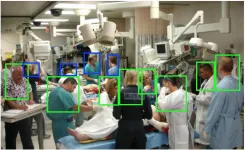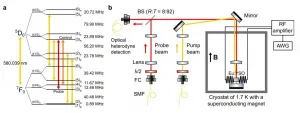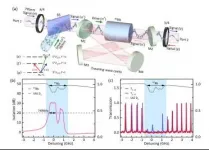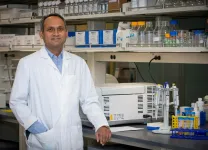(Press-News.org) Computer scientists at the University of California San Diego have developed a more accurate navigation system that will allow robots to better negotiate busy clinical environments in general and emergency departments more specifically. The researchers have also developed a dataset of open source videos to help train robotic navigation systems in the future.
The team, led by Professor Laurel Riek and Ph.D. student Angelique Taylor, detail their findings in a paper for the International Conference on Robotics and Automation taking place May 30 to June 5 in Xi'an, China.
The project stemmed from conversations with clinicians over several years. The consensus was that robots would best help physicians, nurses and staff in the emergency department by delivering supplies and materials. But this means robots have to know how to avoid situations where clinicians are busy tending to a patient in critical or serious condition.
"To perform these tasks, robots must understand the context of complex hospital environments and the people working around them," said Riek, who holds appointments both in computer science and emergency medicine at UC San Diego.
Taylor and colleagues built the navigation system, the Safety Critical Deep Q-Network (SafeDQN), around an algorithm that takes into account how many people are clustered together in a space and how quickly and abruptly these people are moving. This is based on observations of clinicians' behavior in the emergency department. When a patient's condition worsens, a team immediately gathers around them to render aid. Clinicians' movements are quick, alert and precise. The navigation system directs the robots to move around these clustered groups of people, staying out of the way.
"Our system was designed to deal with the worst case scenarios that can happen in the ED," said Taylor, who is part of Riek's Healthcare Robotics lab at the UC San Diego Department of Computer Science and Engineering.
The team trained the algorithm on videos from YouTube, mostly coming from documentaries and reality shows, such as "Trauma: Life in the ER" and "Boston EMS." The set of more than 700 videos is available for other research teams to train other algorithms and robots.
Researchers tested their algorithm in a simulation environment, and compared its performance to other state-of-the-art robotic navigation systems. The SafeDQN system generated the most efficient and safest paths in all cases.
Next steps include testing the system on a physical robot in a realistic environment. Riek and colleagues plan to partner with UC San Diego Health researchers who operate the campus' healthcare training and simulation center.
The algorithms could also be used outside of the emergency department, for example during search and rescue missions.
INFORMATION:
Ph.D. student Sachiko Matsumoto and undergraduate student Wesley Xiao also contributed to the paper.
Social Navigation for Mobile Robots in the Emergency Department
Angelique M. Taylor, Sachiko Mastumoto, Wesley Xiao and Laurel Riek, University of California San Diego
http://cseweb.ucsd.edu/~lriek/papers/taylor-icra-2021.pdf
An international team led by researchers from the Xinjiang Institute of Ecology and Geography (XIEG) of the Chinese Academy of Sciences and the University of Geneva has found that flash floods may triple across the Earth's "Third Pole" in response to ongoing climate change.
Their findings were published in Nature Climate Change on May 6.
The Hindu Kush-Himalaya, Tibetan Plateau and surrounding mountain ranges are widely known as the "Third Pole" of the Earth. It contains the largest number of glaciers outside the polar regions.
Due to global warming, the widespread and accelerated melting of glaciers over ...
Remote quantum distribution on the ground is limited because of the loss of photon in optical fibers. One solution for remote quantum communication lies in quantum memories: photons are stored in the long-lived quantum memory (quantum flash drive) and then quantum information is transmitted by the transportation of the quantum memory. Given the speed of aircrafts and high-speed trains, it is critical to increase the storage time of the quantum memories to the order of hours.
In a new study published in Nature Communications, a research team led by Prof. LI Chuanfeng and Prof. ZHOU Zongquan from University of Science and Technology of China (USTC) extended the storage time of the optical memories to over one hour. It broke the record of one minute achieved by German researchers in 2013, ...
Chinese researchers achieved 51.5dB nonreciprocal isolation in the atomic ensemble, which is the highest isolation ratio in the non-magnetic nonreciprocal field. They discussed the quantum noise problem in nonreciprocal devices for the first time.
The result was published on Nature Communications on April 22, 2021.
Nonreciprocity is an important basic concept in the optical field. The isolators and circulators derived from it are all indispensable components in the optical path. Faraday isolator based on circular birefringence of magneto-optical effect is widely used because of its easy construction, high isolation and low loss.
However, in the integrated optical path, the traditional faraday isolator is subject to various limitations. ...
COLUMBUS, Ohio - Watching meaningful films - those that we find moving and poignant - can make us feel more prepared to deal with life's challenges and want to be a better person, a new study found.
The findings point to one reason why people may choose to see movies that make them sad as well as happy and that may explore difficult subjects that aren't always uplifting.
Researchers found that when people recalled watching meaningful films like The Shawshank Redemption and Up, they reported a variety of positive reactions, such as being better able to accept the human condition and make sense of problems in life.
Those positive experiences were less likely to be reported when people thought about watching Hollywood fare like The Big Lebowski or Catch Me ...
TAMPA, Fla. (May 10, 2021) -- Blocking the fat-busting enzyme lipoxygenase with a synthetic inhibitor throws the immune system's innate inflammatory response out of whack, compromising cardiac repair during acute heart failure, USF Health researchers found.
Their new preclinical study was published April 13 in Biomedicine & Pharmacotherapy.
Acute heart failure - triggered by a heart attack, severely irregular heartbeats, or other causes -- occurs suddenly when the heart cannot pump enough blood to meet the body's demands.
Following a heart attack or any cardiac injury, signals to immune cells called leukocytes ...
WASHINGTON - A neurologic pathway by which non-damaging but high frequency brain impact blunts normal brain function and causes long-term problems with learning and memory has been identified. The finding suggests that tailored drug therapy can be designed and developed to reactivate and normalize cognitive function, say neuroscientists at Georgetown University Medical Center.
The investigators, working with collaborators at the National Institutes of Health, had previously found that infrequent mild head impacts did not have an effect on learning and memory, but in their new study, reported May 10 in Nature Communications (DOI: 10.1038/s41467-021-22744-6), the investigators found that when the frequency of these ...
How is it possible to move in the desired direction without a brain or nervous system? Single-celled organisms apparently manage this feat without any problems: for example, they can swim towards food with the help of small flagellar tails.
How these extremely simply built creatures manage to do this was not entirely clear until now. However, a research team at TU Wien (Vienna) has now been able to simulate this process on the computer: They calculated the physical interaction between a very simple model organism and its environment. This environment is a liquid with a non-uniform ...
The morphological compatibility between flowers and insects was given in the famous textbook example of Darwin's orchids and hawkmoths. As in this example, many studies have shown that geographical variations in flower size match the size of insects in each region. In other words, studies have shown "flower-sized regional adaptation" in which large flowers evolve in areas pollinated by large insects and small flowers evolve in areas pollinated by small insects.
However, when examining the genetic similarity between populations, are plants in each region more similar, or are plants with large ...
A team of researchers at the Institute of Laser Engineering, Osaka University, in collaboration with Bielefeld University and Technical University Braunschweig in Germany, came closer to unraveling the complicated optical response of wide-bandgap semiconductor multiple quantum wells and how atomic-scale lattice vibration can generate free space terahertz emission. Their work provides a significant push towards the application of laser terahertz emission microscopes to nano-seismology of wide-bandgap quantum devices.
Terahertz (THz) waves can be generated by ultrafast processes occurring in a material. By looking at THz emission, researchers have ...
Point-of-Care UltraSonography (POCUS) deployed during the emergency treatment of patients with acute dyspnea has enormous advantages over standard diagnostic pathways. This is the finding of a joint review conducted by Danube University Krems and MedUni Vienna and recently published in the prestigious Annals of Internal Medicine. It allows serious conditions to be identified more quickly so that appropriate treatment can be initiated.
Working on behalf of the American College of Physicians, a joint study group from MedUni Vienna and Danube University Krems conducted a review of the value of Point-of-Care UltraSonography (POCUS) in patients with acute dyspnea (shortness of breath), with a view to drawing up a practical clinical treatment guideline. ...







